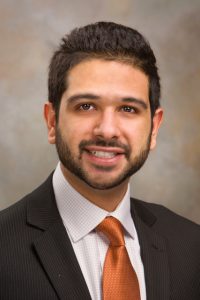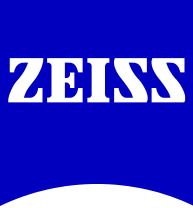RetinaLink’s Following the Fellows is pleased to feature Dr. S. Amal Hussnain. Dr. Hussnain presented a very interesting Ciliary Body Myxoma case and surgical video at Alcon’s Retina Film Festival in Chicago at the American Academy of Ophthalmology. This case was submitted to JAMA in October 2018 for peer review and was accepted for publication. https://jamanetwork.com/journals/jamaophthalmology/article-abstract/2721044
Dr. Hussnain provides both his insight and impressions on several topics including his guidance for retina fellows, small gauge surgery, OCT and his mentors’ influence. See his entire interview below.
RetinaLink: Please outline your academic background.
S. Amal Hussnain, MD (SAH): I attended medical school at Weill Cornell Medical College in New York City, New York. After finishing a Transitional Year internship at Bassett Medical Center in Cooperstown, New York, I moved to New Haven, Connecticut, where I completed ophthalmology residency training at Yale University Department of Ophthalmology and Visual Sciences. Currently, I am in my second year of combined vitreoretinal surgery fellowship at Columbia University, Vitreous Retinal Macula Consultants of New York, Manhattan Eye, Ear and Throat Hospital, and New York University/Bellevue Hospital.
RL: Why did you choose retina?
SAH: On my first day of ophthalmology residency, I performed an intravitreal anti-VEGF injection and within weeks saw the amazing treatment response both in my patient’s vision and on SD-OCT. Never before had I been able to intervene so directly, precisely, and effectively – i.e. deliver a molecule locally against a specific target with my own hands – in the disease course of my patient, and be able to measure the effect objectively.
Then as I started to scrub into surgical cases during my residency training, I realized that I would enjoy the complexity and diversity of vitreoretinal surgery. I like the fact that even though many vitreoretinal cases are challenging, requiring a unique skill set and creative thinking, one can truly make a difference for the patients. I also find the constant innovation in surgical instrumentation, techniques, and technology very exciting.
Lastly, with uveitis, rare infections, and inherited retinal diseases, I knew that there would always be interesting medical retina cases, made even more interesting with the newer imaging, to make you scratch your head every now and then (unless you are K. Bailey Freund, MD).
RL: Who is/are your mentor(s)?
SAH: I am fortunate to be trained and mentored by some of the brilliant minds in the fields of medical retina and vitreoretinal surgery. The list is incredible: Drs. Lawrence Yannuzzi, Tongalp Tezel, K. Bailey Freund, Jason Horowitz, William Schiff, Gaetano Barile, Royce Chen, and Yasha Modi, to name a few. If I were to pick one mentor who has influenced me the most, it would be without hesitation Dr. Stanley Chang. He is the best role model I have come across in my professional life.
Dr. Chang is unmatched in his ability to play so many different roles with excellence, whether as a surgeon, physician, researcher, innovator, or chairman emeritus of an academic department. Most in our field would know about his enormous contributions, such as the wide-angle viewing system and PERFLUORON® perfluorocarbon liquid, which revolutionized vitreoretinal surgery. It is also common knowledge how gifted he is as a surgeon, and operating with him has truly been a treat: every movement, every grasp, every laser spot is deliberate and clearly thought out. In clinic, he always finds something instructional for every patient we see together. So from clinical and surgical training standpoint, it has been an absolute privilege to learn from him.
The most incredible part of working with him though is that he revives one’s idealism in the humanistic aspect of medicine, which is so easy to lose through the stressful and grueling years of training. He demonstrates on a daily basis that in the course of gifting sight through our technical know-how, we ourselves must not lose sight of what is most important: our patients. Once a patient sits in the exam chair, he addresses all of their concerns, not just vision-related. We are talking about one of the most eminent vitreoretinal surgeons of all times with a very busy schedule, yet he finds the time to answer his patients’ e-mails, returns their phone calls, and routinely refracts them. I once asked him what drives and motivates him, to which he simply said, “I get happy when my patients do well.” I think if we make this our ultimate goal, then medicine becomes a very rewarding profession.
RL: What’s your preferred small gauge platform and why? Do you ever utilize hybrid gauges – 25/27? 23/25?
SAH: I have done a large majority of my cases with the 25-gauge during my fellowship so far, but have also used the 23- and 27- gauge platforms. Currently, 25-gauge is my go to, unless it is a case that involves, or has the potential for, lensectomy or silicone oil. Rob Finley and Russ Finlay from Alcon introduced me to the beveled 27-gauge HYPERVIT vitrectomy probe with 20,000 cpm, and I felt that I could perform vitrectomy with the same efficiency as with the 25-gauge.
RL: Do you utilize iOCT in your OR? If you do utilize it, how frequently do you change your surgical plan based on your intraoperative findings?
SAH: We do not utilize iOCT in our OR, but we do pay very close attention to the structural and en-face OCT pre-operatively in preparation of our macular cases. Dr. Stanley Chang recently presented findings of our study at the 2018 Retina Society where we describe a feature we call schisis of the retinal nerve fiber layer (sRNFL) in a series of epiretinal membrane cases. We found that sRNFL is a relatively common finding in ERM cases and can help surgeons decide using OCT where to start the membrane peeling and which areas to avoid, as peeling in areas with schisis of RNFL could lead to further damage.
RL: What is your best advice for the incoming fellows starting in July 2019?
SAH: There has always been an obsession by trainees with surgical numbers and volume both during residency and fellowship. While it is certainly true that the more you do of something, the better you become at it (and this continues after you graduate from fellowship), vitreoretinal surgery is unique in its diversity of cases compared to other ophthalmic subspecialties. I would suggest not only keeping your eye on the total number of primary cases, but also paying attention to the quality and breadth of cases. At a certain point, you can learn more from doing parts of a tough TRD or PVR case than doing another non-clearing vitreous hemorrhage as the primary surgeon. Secondly, learn the “art” of vitreoretinal surgery, i.e. when and which surgery to do, by having in-depth discussions with your mentors about surgical cases. For example, opting for vitrectomy for a young phakic patient with chronic retinal detachment who you should buckle instead, can make all the difference in the outcome.
RL: Where will you practice when you complete your fellowship?
SAH: I am heading back to my hometown Albany, New York, where I have a lot of family and strong ties to the community. I will be joining Dr. Amjad Hammad, the current president of New York State Ophthalmological Society, and his colleague Dr. Salman Yousuf, at Saratoga Ophthalmology.
RL: What is your favorite thing to do when you have some free time?
SAH: I am blessed with an amazing, large family and my favorite thing is to spend time with them, especially with my son Raza. I am also a cricket fanatic and follow the sports closely, though do not get much time to play anymore, but I hope that will change after fellowship ends.
Dr. Hussnain can be reached via e-mail – [email protected]
*** Following the Fellows is an ongoing series sponsored by ZEISS.


